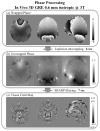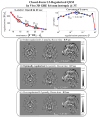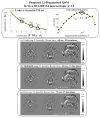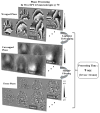Fast quantitative susceptibility mapping with L1-regularization and automatic parameter selection
- PMID: 24259479
- PMCID: PMC4111791
- DOI: 10.1002/mrm.25029
Fast quantitative susceptibility mapping with L1-regularization and automatic parameter selection
Abstract
Purpose: To enable fast reconstruction of quantitative susceptibility maps with total variation penalty and automatic regularization parameter selection.
Methods: ℓ(1) -Regularized susceptibility mapping is accelerated by variable splitting, which allows closed-form evaluation of each iteration of the algorithm by soft thresholding and fast Fourier transforms. This fast algorithm also renders automatic regularization parameter estimation practical. A weighting mask derived from the magnitude signal can be incorporated to allow edge-aware regularization.
Results: Compared with the nonlinear conjugate gradient (CG) solver, the proposed method is 20 times faster. A complete pipeline including Laplacian phase unwrapping, background phase removal with SHARP filtering, and ℓ(1) -regularized dipole inversion at 0.6 mm isotropic resolution is completed in 1.2 min using MATLAB on a standard workstation compared with 22 min using the CG solver. This fast reconstruction allows estimation of regularization parameters with the L-curve method in 13 min, which would have taken 4 h with the CG algorithm. The proposed method also permits magnitude-weighted regularization, which prevents smoothing across edges identified on the magnitude signal. This more complicated optimization problem is solved 5 times faster than the nonlinear CG approach. Utility of the proposed method is also demonstrated in functional blood oxygen level-dependent susceptibility mapping, where processing of the massive time series dataset would otherwise be prohibitive with the CG solver.
Conclusion: Online reconstruction of regularized susceptibility maps may become feasible with the proposed dipole inversion.
Keywords: L-curve; Quantitative susceptibility mapping; Regularization; Total variation.
Copyright © 2013 Wiley Periodicals, Inc.
Figures










References
-
- Fan AP, Bilgic B, Benner T, Rosen BR, Adalsteinsson E. Regularized Quantitative Susceptibility Mapping for Phase-based Regional Oxygen Metabolism (PROM) at 7T. Proc Intl Soc Mag Reson Med; 2011; Montreal, Canada. p. 7942.
Publication types
MeSH terms
Grants and funding
LinkOut - more resources
Full Text Sources
Other Literature Sources
Medical

